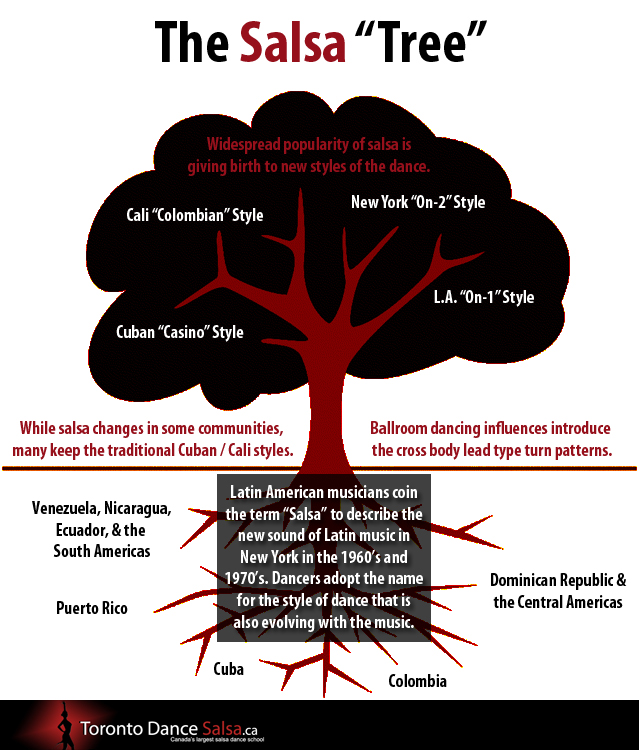Getting The Dance San Francisco To Work
Table of ContentsNot known Details About Dance San Francisco The Best Strategy To Use For Dance San FranciscoThe Main Principles Of Dance San Francisco Facts About Dance San Francisco Uncovered
Allow's think about Salsa dancing and music as a large Tree that appears like this: Salsa is danced global while several technical elements of the dancing are the very same throughout designs (6 actions over 8 beats danced on a quick-quick-slow or slow-quick-quick rhythm), there are a number of "trademark" features of the primary designs of Salsa that identify one from the other.Pairs participating in a Casino site Rueda dance all relocate unison as called by a Leader. Distinct attributes of Cuban style salsa are round turn patterns (with "break back" actions on counts 1 and 5) along with body language motivated by traditional Afro-Cuban folkloric dancings. Distinct functions of Cali style salsa fasts and intricate footwork, danced with a solid hand hold connection between partners.
The origins of the design are a topic of dispute, but it is claimed that New york city design Salsa dancing stemmed in the 1960's as a result of the influx of Latin American emigrants after the Cuban Change (salsa dancing sf). Eddie Torres is the most popular New York style professional dancer, being virtually globally attributed with popularizing the style to dance centres beyond New york city
The fundamental rhythm of "On-2" is slow-quick-quick. The "youngest" of the designs of Salsa, L.A (https://evans-wondrous-site-756696.webflow.io/). Style (some people have actually called it "West Coastline" design) came to be prominent in the 1990's and has its beginnings in ballroom (Mambo, Swing and Cha, Cha, Cha). Turn patterns lead and follow techniques are heavily affected by these styles, with the Cross Body Lead being the cornerstone of the design
The 5-Minute Rule for Dance San Francisco
Design are execution of turn patterns and numbers in the "port", with the break steps on counts "1" and "5". This design is additionally characterized by fancy and commonly detailed arm designing by the comply with to accent the "1" and "5" matters. The fundamental rhythm of "On-1" is quick-quick-slow. While Salsa music has solid origins in Cuban, Colombian and Puerto-Rican folkoric traditions, it can not be marked down that all Afro-Latin and Latin American societies have added to contemporary Salsa music as we recognize it today.


Our Dance San Francisco Ideas
differentiating features of Salsa music are: 4/4 measure signature, Boy Clave and Tumbao rhythms, Montuno Piano Unless you have a history in songs, the above 3 features most likely mean nothing to you. A less complicated way to define Salsa music is exactly how it does NOT seem like various other sorts of Latin American popular music.

It's time for lessons. With a lot of studios out there and different styles to select from, where does a complete rookie begin? Most brand-new dancers select to discover L.A. "On-1" style slotted Salsa styles are the most prevalent in The United States and Canada (with some exemptions of some metropolitan centres that still mainly accept Cuban and Puerto Rican designs) and L.A.
.A. Style will quickly instruct you the basics of Salsa timing, weight transfer and turn pattern execution. Many dancers, when they've had a year or more of dancing L.A. Style Salsa under their belts, "switch" to New york city design in order to expand their dancing vocabulary; however several professional dancers decide to stay with just one design of Salsa and appreciate their time on the dance floor in that particular style. salsa dancing sf.
Style and New York Design all being danced in the very same club, with a number of the professional dancers having the ability to switch from one design to the various other from one song to the following. salsa dancing sf. Regardless of which design you select it is very important to stick to that design till you're very comfy with the principles of timing, body rhythm and structure step execution prior to taking into consideration "changing" designs (if you intend to)
When you embark on lessons be all set to commit time and energy to discovering how to dance as a whole it takes a full novice (i. e., someone with little or no dancing experience) regarding 6 months of proactively taking lessons and heading out and exercising a minimum of two times a week to get to a point where pattern implementation starts to really feel "natural".